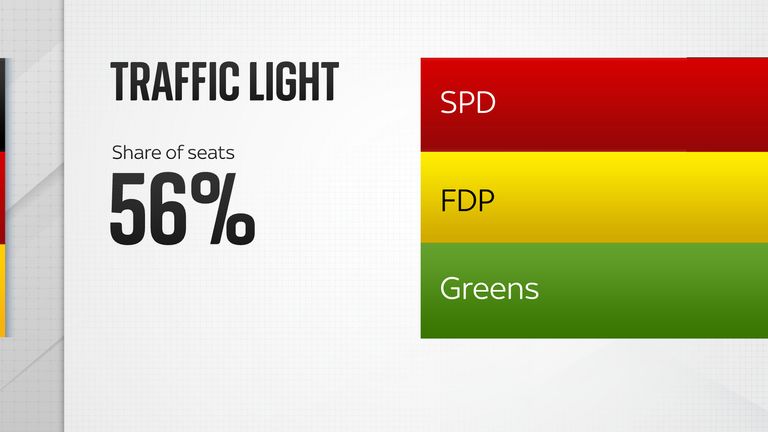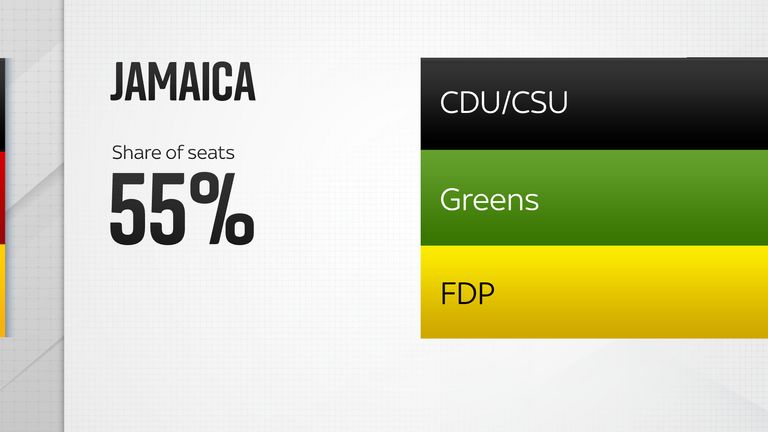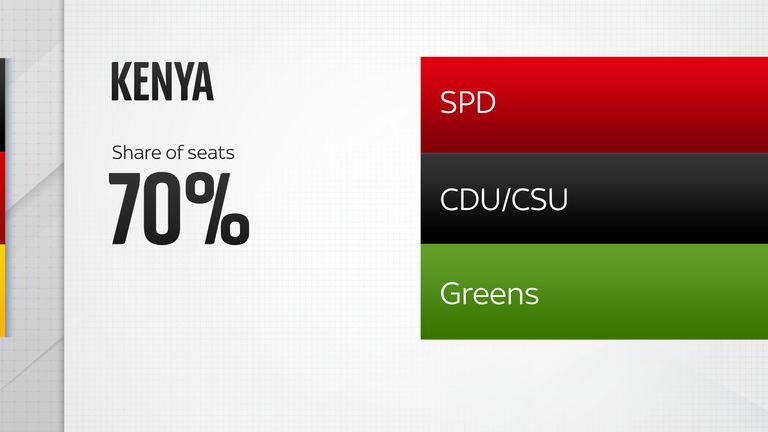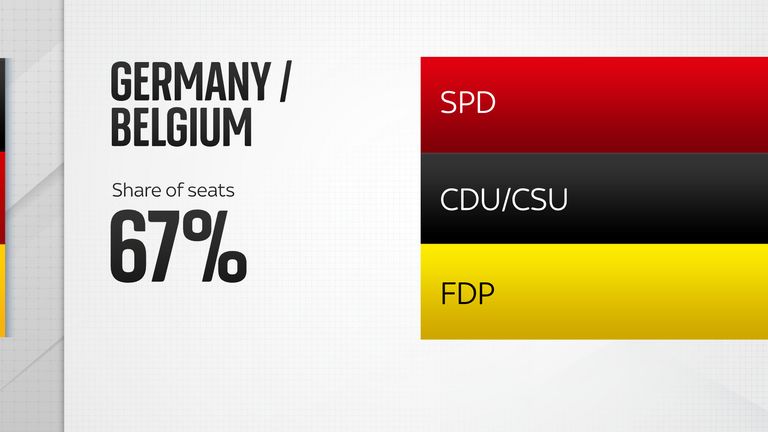German election: What will the make-up of the ruling coalition look like?
Monday 27 September 2021 15:50, UK
Olaf Scholz, the candidate for chancellor for the party with the most seats after the German election, says he is ready to start negotiations to form a coalition that will allow him to lead his country.
But the Social Democratic Party's (SPD's) Mr Scholz has a battle on his hands.
Few of the potential coalition partners will make easy bedfellows, and few combinations will come together easily. It's still possible that Mr Scholz's rivals the Christian Democratic Union party (CDU) could form a government.
It could take weeks; it could take months (Mr Scholz hopes to strike a deal by Christmas). It might not even happen without another election.
In any case, in the meantime, Angela Merkel and her current government stay in place as caretakers, until a new coalition agreement is ratified by the German parliament.
As for coalitions, these are the most likely possibilities:
The traffic light coalition is so-called because it is made up of the red colour of the SPD, the yellow of the Free Democrats (FPD), and the green of the Greens.
Within a few hours of the election result being known, Mr Scholz said he aimed to reach an agreement to form a coalition government with the Greens and the FDP before Christmas. Experts have said this deadline will be difficult.
To do so, he will have to do something that has never been achieved before - a federal coalition involving the pro-environmental Greens and the pro-business FDP.
The candidate for the Free Democrats, Christian Lindner, has said in the past that he would not enter a coalition led by the Greens.
Although this particular coalition would not be led by the Greens, the party has significant sway over the direction the coalition would take. This may be unpalatable to Mr Lindner's party members, who have always been more comfortable entering coalitions with the CDU/CSU.
Annalena Baerbock, the leader of the Greens, has expressed her determination that the next German government will be a "climate government", but, if that requires higher taxation, Mr Lindner's FDP will not be pleased.
There is little doubt, there are some tough months ahead for Mr Scholz's negotiations.
The Jamaican coalition is so-named because it is the colours of the Jamaican flag: the black of the CDU/CSU, green (Greens), and yellow (FDP).
While the CDU/CSU has worked with the FDP in the past on a number of occasions, neither has experience of working with the Greens in federal government.
Yet, even though this coalition failed when Mrs Merkel attempted it in 2017, it remains a possibility.
That's because Mr Lindner stated his interest in a government alliance with the CDU and the Greens two days before the election - perhaps indicating he may be more willing to work with Ms Baerbock under a more conservative coalition framework.
The Greens were described as remaining sober about the prospect ahead of the vote, but they are also considered pragmatic, so long as they are able to get the policies they want into place.
Assuming the Greens and the FDP are likely kingmakers in the coalitions that will end up governing, Mr Lindner has proposed that his party and the Greens get together - even before starting to talk to the SPD or the CDU - to work out what they would require from any agreement.
The last government was run by a "grand coalition" of the two main parties: the CDU/CSU and the SPD. The CSU is the equivalent to the CDU in Bavaria and almost always votes with them at the federal level.
The difference with this grand coalition would be that the SPD would be the biggest party, so it is likely Mr Scholz would be the chancellor, rather than anyone from the CDU, as Mrs Merkel was in the last government.
But many German commentators have said that, this time, a grand coalition is less likely because the vote share indicates Germans are wanting change, and have rejected the political status quo seen for several of the previous election results.
Yet, after a Jamaica coalition failed to be formed in 2017, Mrs Merkel had no choice but to attempt to form her grand coalition, and that may occur this time, even though both candidates have ruled it out.
The red of the SPD, the green of the Greens, and the black of the CDU makes up the "Kenya" coalition possibility, after the colours of the Kenyan flag.
This would face many of the difficulties that the grand coalition faces, but probably even more, as both of the main parties would have to accommodate demands from the environmentally-focused Greens.
In the event it came about, however, it would potentially be a more powerful coalition as it would have a larger share in the German Bundestag, and could fight off minor rebellions by individual or small groups of MPs.
In any event, this is considered unlikely.
This slightly confusingly named coalition is named after the colours of the German and Belgian flags - red, black, and yellow.
The combination of the SPD (who would probably lead), the CDU/CSU and the FPD has also never been achieved at federal level, but the FPD has worked with both in national government.
Like the Kenya option, while also not very likely, it would have the advantage of being a strong government, if a firm coalition agreement could be brokered.
Red-red-green is so-called because the third partner in such a coalition is the Left party, the descendant of the former communist party in East Germany, that evolved after unification.
The party is usually represented by pink in Germany's rainbow politics, but it actually uses red in its logo.
This combination - which was considered such a possibility before the vote that the CDU actively warned voters about the risk of it - would not reach the 50% threshold required for a majority.
But, if Mr Scholz fails in his bid to create the traffic light and senses that the mood is against a coalition with the CDU, he may try to attempt this as a minority government - something that also has no precedent.
If he is successful, it would mean the most left wing and potentially radical government Germany has seen in modern times, but this is considered highly unlikely.
No agreement
If no agreement can be reached, it will be up to German President Frank-Walter Steinmeier to decide how to proceed.
He would be bound to explore whether any other coalition can be achieved. If not, any of the parties could try to oust their chosen candidate to choose another potential candidate who could form a working coalition.
As in the red-red-green option above, it is possible a different minority government could be formed, but this has never been done in the past.
What is most likely is that, once all the mathematically possible coalitions have been exhausted, Mr Steinmeier would have no choice but to call another election - either with the same candidates, or different ones, if the parties opt for it.
No agreement is possibly more likely than several of the options above.










